DCS dCS 904 User Manual
dCS 904
Analogue to Digital Converter
User Manual
Standard Software version 1.5x
P3D Software version 1.36
June 2000
© 1997, 1999, 2000 dCS Ltd
All rights reserved. Reproduction of this manual in any manner whatsoever, without the written permission of dCS1 is strictly forbidden. Additional copies of this manual may be obtained from dCS.
Information contained in this manual is subject to change without notice, and whilst it is checked for accuracy, no liabilities can be accepted for errors.
1 |
dCS |
Ltd is Data Conversion Systems Ltd. Company registered in the England no. 2072115 |
|
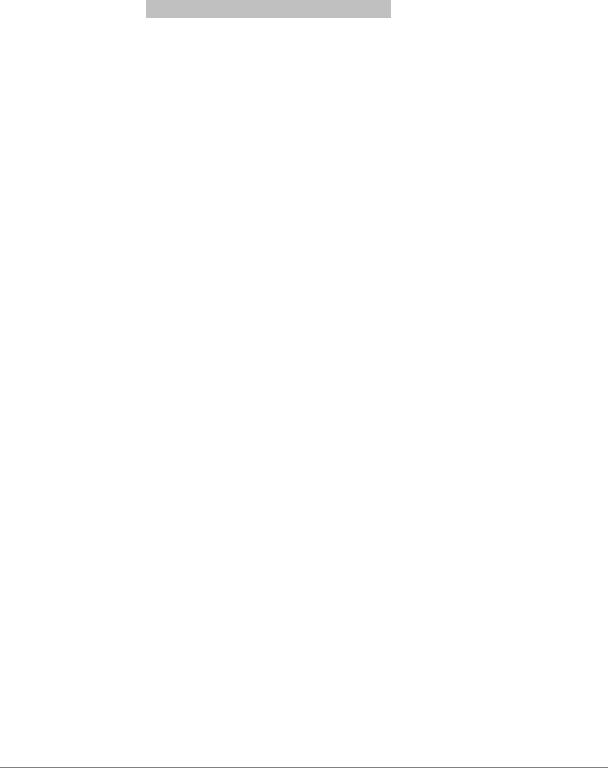
dCS 904 User Manual |
Manual for Software Version 1.5x and 1.36 |
dCS Ltd |
June 2000 |
|
|
PRODUCT FEATURES
Formats
•DSD, and PCM from 192 kS/s down to 32 kS/s
•Data formats supported are: AES/EBU (XLR and BNC), Dual AES (XLR), Quad AES (XLR), AES data at TTL levels, and SDIF-2 (PCM and DSD), SDIF-3 (DSD), DSD packed into 4 AES links
•P3D option: DSD packed into 3 AES links
Syncing
• Operates in Master mode or can sync to Word Clock or AES reference, or signal, and sync to video option available
Functions
•Very high performance ADC, free from gain ranging
•High quality VCXO internal clocking in Master mode
•Multichannel Sync capability
•Noise shaping truncation (1st, 3rd, 9th order)
•High speed or dual AES (88.2 kS/s, 96 kS/s)
•Dual or Quad AES (176.4 kS/s and 192 kS/s)
•Data mode – can take in digital data in both PCM and noise shape/truncate it, and in DSD can re-pack it
Test Generator
• High quality (160 dB) signal generator with mHz resolution. Can be noise
shaped truncated
Ease of Use
•Remembers last settings
•Lockouts
•Software upgrade-able without opening the box
•Can be remote controlled from PC
Manual part no: DOC135904 iss 2B2 |
Page 2 |
135904ma2b2.pdf file available from website |
Contact dCS on + 44 1799 531 999 |
email to: more@dcsltd.co.uk |
(inside the UK replace + 44 with 0) |
web site: www.dcsltd.co.uk |

dCS 904 User Manual |
Manual for Software Version 1.5x and 1.36 |
dCS Ltd |
June 2000 |
|
|
Manual part no: DOC135904 iss 2B2 |
Page 3 |
135904ma2b2.pdf file available from website |
Contact dCS on + 44 1799 531 999 |
email to: more@dcsltd.co.uk |
(inside the UK replace + 44 with 0) |
web site: www.dcsltd.co.uk |

dCS 904 User Manual |
Manual for Software Version 1.5x and 1.36 |
dCS Ltd |
June 2000 |
|
|
CONTENTS |
|
|
|
Product Features ................................................................................................ |
|
2 |
|
CONTENTS.......................................................................................................... |
|
4 |
|
|
About this Manual |
|
5 |
Using Your dCS 904 For The First Time ............................................................ |
|
6 |
|
|
Product Overview |
|
6 |
|
What’s in the Box? |
|
6 |
|
Mains Voltages |
|
6 |
|
Installing Unit in a Rack |
|
7 |
|
Getting Started |
|
8 |
The Hardware – Controls and Connectors..................................................... |
|
10 |
|
|
Rear Panel |
|
10 |
|
Front Panel |
|
12 |
The Software – the Menu ................................................................................. |
|
18 |
|
|
Overview |
|
18 |
|
The Menu Sequence |
|
19 |
|
Menu Items |
|
20 |
Typical Applications......................................................................................... |
|
24 |
|
|
Using a dCS 904 to output DSD |
|
24 |
|
Using a Master Clock to Sync a dCS 904 |
|
24 |
|
Storing DSD on an 8 track 16/44.1 PCM Recorder |
|
25 |
|
Six Channel PCM Set Up |
|
25 |
|
Storing 6 channel DSD on a 24 track 16/44.1 PCM Recorder |
26 |
|
|
Operating Several Units on One Remote Chain |
|
27 |
|
8 Channel P3D DSD Set Up with Monitoring |
|
28 |
dCS 904 Technical Information......................................................................... |
|
30 |
|
|
Anti Alias Filtering |
|
30 |
|
Clocking |
|
31 |
|
DSD |
|
32 |
|
Sample Alignment |
|
37 |
|
Noise Shaping |
|
41 |
|
Digital Interface Specifications |
|
44 |
|
Analogue Input Specifications |
|
45 |
|
Digital Data Formats Supported |
|
46 |
|
AES3 (AES/EBU) Format |
|
47 |
|
SDIF-2 |
|
50 |
|
RS-232 Remote Control Interface |
|
53 |
|
Power Consumption |
|
62 |
|
Size and Weight |
|
62 |
|
Operating Conditions |
|
63 |
General Technical Information........................................................................ |
|
64 |
|
|
Word Length Reduction |
|
64 |
Options .............................................................................................................. |
|
68 |
|
Maintenance and Support................................................................................ |
|
70 |
|
|
Hardware |
|
70 |
|
Software |
|
71 |
|
Hardware Update or Calibration |
|
72 |
|
Warranty |
|
72 |
|
Safety and Electrical Safety |
|
72 |
TroubleShooting............................................................................................... |
|
74 |
|
|
Error Codes and Messages |
|
74 |
Manual part no: DOC135904 iss 2B2 |
Page 4 |
135904ma2b2.pdf file available from website |
|
Contact dCS on + 44 1799 531 999 |
email to: more@dcsltd.co.uk |
(inside the UK replace + 44 with 0) |
web site: www.dcsltd.co.uk |
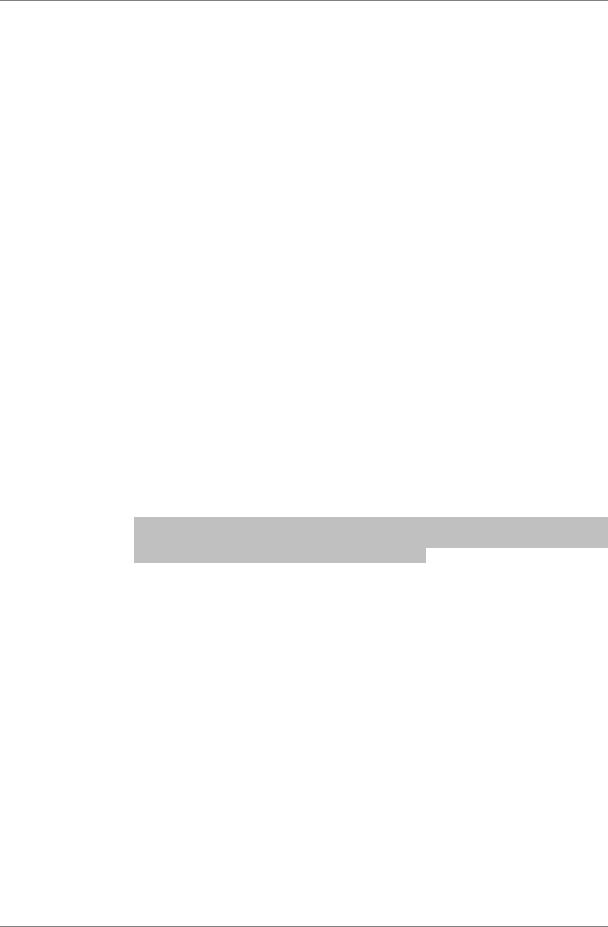
dCS 904 User Manual |
Manual for Software Version 1.5x and 1.36 |
|
dCS Ltd |
|
June 2000 |
|
Internal Device Error Codes |
74 |
|
System Messages and Error Codes |
75 |
|
Trouble Shooting Your System |
75 |
|
dCS Support....................................................................................................... |
77 |
|
I wish .... |
77 |
|
If You Need More Help |
77 |
|
Other Information |
77 |
|
Indexes and Software Version Numbers........................................................ |
79 |
|
Definitions of Units |
79 |
|
Full Contents |
80 |
|
Tables |
83 |
|
Figures |
84 |
|
Keywords and Phrases |
85 |
About this Manual
Note that there is a fuller Contents at the end of the manual (page 80), along with an index and lists of figures and tables.
References to other sections in the text have the "Section Name” page … in quotation marks and bolded.
IMPORTANT! Important information is presented like this - ignoring this may cause you to damage the unit, or invalidate the warranty.
The manual covers standard units and units with P3D option. P3D is a DSD data format, and these units have changed internal hardware to accommodate it. Information that is specific to P3D units is greyed.
The manual is designed to be helpful. If there are points you feel we could cover better, or that we have missed out - please tell us.
Manual part no: DOC135904 iss 2B2 |
Page 5 |
135904ma2b2.pdf file available from website |
Contact dCS on + 44 1799 531 999 |
email to: more@dcsltd.co.uk |
(inside the UK replace + 44 with 0) |
web site: www.dcsltd.co.uk |

dCS 904 User Manual |
Manual for Software Version 1.5x and 1.36 |
dCS Ltd |
June 2000 |
|
|
USING YOUR dCS 904 FOR THE FIRST TIME
Product Overview
The dCS 904 ADC (Analogue to Digital Converter) is a high performance converter designed for studio and live recording applications. It is designed to produce very high standard digital output (for example, 192 kS/s or DSD) that may be used directly or archived. If these formats are used, lower resolution formats (for example Red Book CD) may produced by subsequent downsampling. AES3, SPDIF, SDIF-2 PCM formats and several DSD formats are all supported. Multiple units may be slaved together for stable multi-channel operation.
The unit is mains powered and is housed in a 1U (1.75”) high 19” rack mounting case. It may be controlled either from its front panel, or from a software based remote control running on a PC via a com port. The unit’s last setting is automatically stored on power down, so that fixed installations may be set up at leisure, installed and then left alone. Unauthorised alterations to settings may be prevented by a “panel lock out” feature.
The unit is highly software based, and more functions and features are added from time to time. Software updates from dCS are free!2
What’s in the Box?
The contents of the box are at least:
dCS 904
User Manual Quick Start Guide Mains Lead
2 Spare Fuses Remote cable Remote software
Mains Voltages
The dCS 904 is shipped with its mains voltage preset for operation in the destination country. The voltage is not intended to be changed by the user. If it needs to be changed, contact your dealer or dCS.
IMPORTANT! The dCS 904 must be used with a mains earth!
2free if we email them, and you download from a PC com port. Low cost if you ask us for EPROMs or other media - we charge for media and handling.
Manual part no: DOC135904 iss 2B2 |
Page 6 |
135904ma2b2.pdf file available from website |
Contact dCS on + 44 1799 531 999 |
email to: more@dcsltd.co.uk |
(inside the UK replace + 44 with 0) |
web site: www.dcsltd.co.uk |

dCS 904 User Manual |
Manual for Software Version 1.5x and 1.36 |
dCS Ltd |
June 2000 |
|
|
Installing Unit in a Rack
The unit is supplied with 19" rack mount ears fitted. If it is to be mounted in a 19" rack, the ears supplied may be used to locate it in the rack and stop the unit sliding forward – but they are not strong enough to support the unit.
IMPORTANT! The ears should not be used as the only mechanical support. The unit should rest on a shelf, or be supported in some other way. The ears will just locate it in the rack, and stop it sliding forwards.
If the unit is not to be rack mounted, the ears may be removed.
Manual part no: DOC135904 iss 2B2 |
Page 7 |
135904ma2b2.pdf file available from website |
Contact dCS on + 44 1799 531 999 |
email to: more@dcsltd.co.uk |
(inside the UK replace + 44 with 0) |
web site: www.dcsltd.co.uk |

dCS 904 User Manual |
Manual for Software Version 1.5x and 1.36 |
dCS Ltd |
June 2000 |
|
|
Getting Started
Here’s what to do:
(If the unit does not behave the first time you power up – contact your dealer, or dCS.)
do this: Check the appropriate mains supply for your local mains is marked on the rear panel.
do this: If it is, using the lead supplied, connect the unit to the mains - connect no other leads at this stage - and switch on.
The seven segment display will briefly show:
- - - - 4
and then the sample rate, for example:
1 9 2
do this: Connect a signal source to the analogue inputs.
do this: Connect an output (eg from AES1) to your system or a DAC.
do this: Press the Sample Rate button (left hand end button) to get the sample rate you want. Press the Output Format button (right hand end) to get the format you want.
Set up like this, the dCS 904 will operate in Master mode, and the system it is connected to will (have to) lock to it. You should have audio.
Use any of AES1, AES2, AES3, or AES4 as an output at 32 kS/s or 44.1 kS/s or 48 kS/s, or for double speed AES at 88.2 kS/s or 96 kS/s.
Use (AES1 + AES2) or (AES3 + AES4) for dual AES 88.2 kS/s or 96 kS/s or 176.4 kS/s or 192 kS/s.
Use all of (AES1 + AES2 + AES3 + AES4) for quad AES 176.4 kS/s or 192 kS/s. For DSD, see the DSD section.
Note that all the outputs are active simultaneously on the dCS 904. If the mode the unit is in needs them to be different, they will be – otherwise they will be the same, and may all be connected to external equipment simultaneously if required.
Now you will need to familiarise yourself with how the front panel controls and the menu system work.
do this: Read the short section on “The Software – the Menu” on page 18 so you know how the buttons and menu work.
You may also find it convenient to refer to the Quick Start Guide while you are getting to know the unit.
Manual part no: DOC135904 iss 2B2 |
Page 8 |
135904ma2b2.pdf file available from website |
Contact dCS on + 44 1799 531 999 |
email to: more@dcsltd.co.uk |
(inside the UK replace + 44 with 0) |
web site: www.dcsltd.co.uk |

dCS 904 User Manual |
Manual for Software Version 1.5x and 1.36 |
dCS Ltd |
June 2000 |
|
|
Manual part no: DOC135904 iss 2B2 |
Page 9 |
135904ma2b2.pdf file available from website |
Contact dCS on + 44 1799 531 999 |
email to: more@dcsltd.co.uk |
(inside the UK replace + 44 with 0) |
web site: www.dcsltd.co.uk |
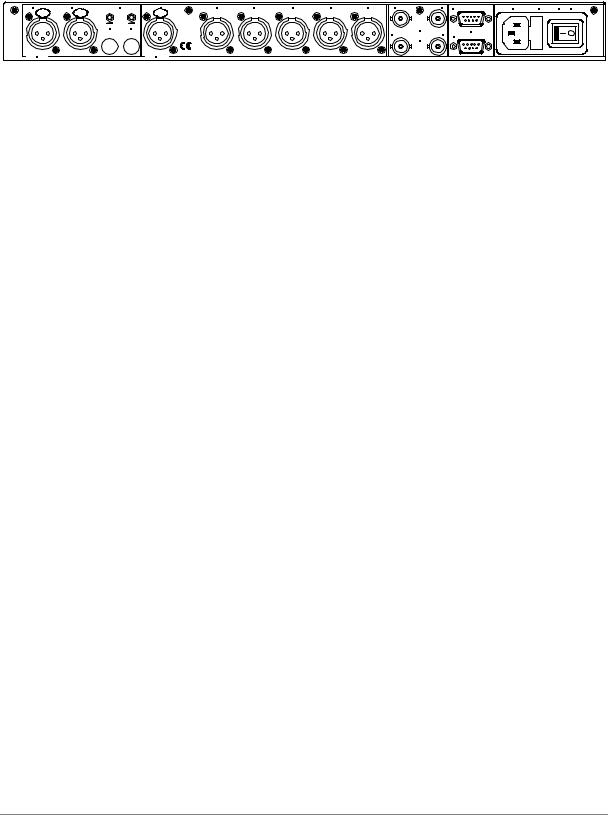
dCS 904 User Manual |
Manual for Software Version 1.5x and 1.36 |
dCS Ltd |
June 2000 |
|
|
THE HARDWARE – CONTROLS AND CONNECTORS
Rear Panel
CH1(L) |
CH2(R) |
Sensitivity |
Reference In |
Reference Out |
AES1 |
AES2 |
AES3 |
AES4 |
CH1 |
|
CH2 |
In |
MAINS FUSE 2A(T) ON OFF |
PUSH |
PUSH |
|
PUSH |
|
|
|
|
|
|
|
|
|
|
|
|
CH1(L) CH2(R) |
|
|
|
|
|
|
In |
SDIF-2/DSD |
Out |
|
Remote |
|
|
|
|
|
|
|
|
|
Out |
||||
|
|
|
|
|
|
|
|
|
75R |
|
|||
|
|
|
|
|
|
|
|
|
|
Clk |
|
|
|
Analogue |
|
|
Digital I/O |
|
|
|
|
|
|
|
|
|
|
Figure 1– Rear Panel
All input and output connectors are mounted on the rear panel. Individual connectors are clearly identified by the panel legend. Viewed from the rear from left to right, the connectors are as follows:
Balanced Analogue Inputs |
3 pin XLR female (2 off) |
Input Level Adjustment |
(trimmers) |
Two multi-turn potentiometers set the full scale input levels. These are factory preset for full scale with input levels of +20dBu. If necessary, adjust with a suitable trim tool or a small screwdriver. Turn clockwise for increased gain. Take care to ensure the stereo inputs remain in balance. The trim range is ±6dB.
Reference In |
3 pin XLR female |
Reference Out |
3 pin XLR male |
Reference In is an AES/EBU reference input for synchronising the unit to a Master Clock. Reference Out is an unbuffered loop through, directly coupled to it, for use in a reference daisy chain. A terminating resistor may be turned on or off, using the menu (see Ref In command, page 23), if several units are to be daisy chained with the same word clock.
In addition, under the control of the ADC/Data button, the Reference In connector can be used as a data input. In this mode, it takes data from the input instead of from the internal ADC, and allows all the formatting and DSP functions (such as noise shaping and word length control) to be applied to input data. See page 14.
AES1, 2, 3 & 4 Digital Outputs |
3 pin XLR male (4 off) |
Four AES/EBU outputs which may be used independently or in groups of two or four. They are used for the various PCM formats, including normal and double speed and two and four wire, and also for some DSD formats.
SDIF/DSD CH1, CH2 Data |
BNC (2 off) |
These BNC connectors can be both outputs and inputs. In normal operation they are outputs for SDIF-2 encoded PCM, or for SDIF-2 and SDIF-3 encoded DSD. They are both TTL level signals for a 75 ohm line. They can be set to TTL level AES3 coded signals, using the menu (see the BNC O command, page 22).
In addition, they can be used for data input, for re-formatting DSD data, under the control of the ADC/Data button (see page 14)
Manual part no: DOC135904 iss 2B2 |
Page 10 |
135904ma2b2.pdf file available from website |
Contact dCS on + 44 1799 531 999 |
email to: more@dcsltd.co.uk |
(inside the UK replace + 44 with 0) |
web site: www.dcsltd.co.uk |

dCS 904 User Manual |
Manual for Software Version 1.5x and 1.36 |
dCS Ltd |
June 2000 |
|
|
SDIF/DSD Clk In |
BNC |
SDIF/DSD Clk Out |
BNC |
This pair take in and give out Word Clock, and can be set to Bit Clock for DSD. The functions are set by the menu. Clock In is terminated and Clock Out is regenerated internally, so these lines can be used for daisy chaining many units together, without loading problems. See Figure 18 and Figure 19 for the time alignment of these signals.
Remote In & Out |
9 pin D type male (2 off) |
If the Windows™ Remote software is in use, connecting Remote In to a com port (RS-232 port) on a PC running the Remote Control program allows the unit to be controlled by the PC. Remote Out may be connected to another suitably equipped dCS unit, allowing several units to controlled by the same PC with one RS-232 daisy chain. In addition, the unit may be software upgraded without removing the lid by downloading new software via the Remote In port – see
Installing New Software on page 71.
Connect up Remote ports using a 9-way screened cable, fitted with 9-way ‘D’- type connectors at each end, wired pin 1 to pin 1, pin 2 to pin 2, etc. The same type of cable can be used unit to units as com port to first unit. Suitable cables are available from dCS.
Mains Supply |
3 pin IEC (CEE22) |
Switched, fused and filtered IEC mains connector.
Additional Information
As well as connectors, the rear panel displays the following information about the unit, near the mains supply connector:
Mains Voltage |
The actual voltage setting supplied. |
Model Number |
dCS 904 |
Manufacturers Name and Country of origin (dCS Ltd, UK)
Serial Number
The underside of the unit will have a label on that contains a number such as 904 4B1 6B2 2A1 3A2 12345. This is the serial number, but it also contains vital configuration information. We will need this number (all of it) to give you support over the phone, or to ship you software updates.
Manual part no: DOC135904 iss 2B2 |
Page 11 |
135904ma2b2.pdf file available from website |
Contact dCS on + 44 1799 531 999 |
email to: more@dcsltd.co.uk |
(inside the UK replace + 44 with 0) |
web site: www.dcsltd.co.uk |
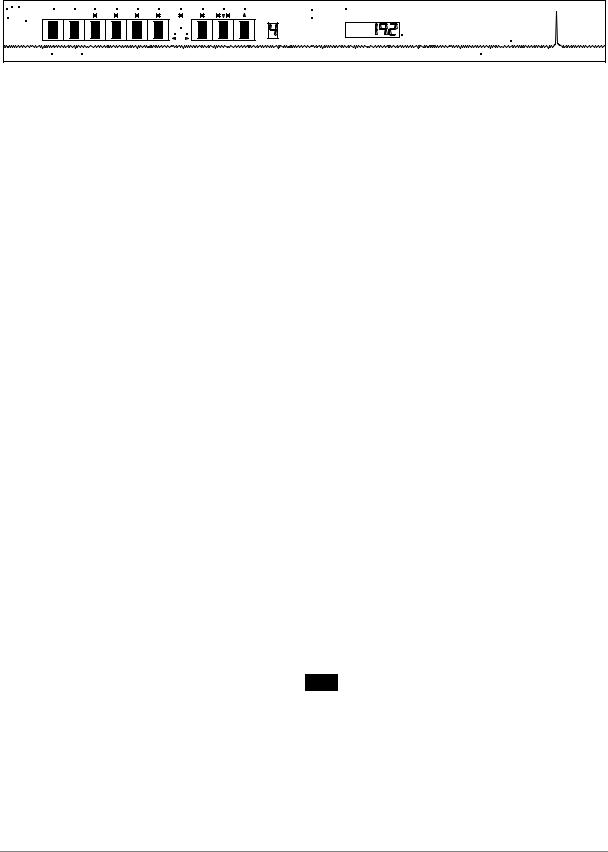
dCS 904 User Manual |
Manual for Software Version 1.5x and 1.36 |
dCS Ltd |
June 2000 |
|
|
Front Panel
24 |
BIT |
Sample |
Multiplier |
Mute |
Word |
Noise |
Overload |
Overload |
ADC/ |
Master Slave |
Output |
DSD |
Sample Rate |
|
|
|
Rate |
Length |
Shaping |
Level |
Data |
Format |
|
||||||||
192kHz |
|
|
|
|
|
|
|
|
|
|
|
Direct Stream Digital |
|
dC S |
|
|
|
|
|
|
|
|
|
MENU |
|
|
|
|
|
||
|
|
|
|
|
|
|
|
Step |
Set |
|
|
|
|
kS/s |
|
|
|
|
|
|
|
|
|
|
|
|
|
|
|
|
|
|
|
dCS 904 A to D Converter |
|
|
|
|
|
|
|
|
|
|
Data Conversion Systems |
||
Figure 2 – Front Panel
The dCS 904 uses a combination of front panel buttons for frequently changed functions and a step through menu for features you might set and forget.
Sample Rate
Multiplier
The 2 buttons on the left side of the front panel select the sample rate. Press the Sample Rate button repeatedly to cycle through the sample rates in the order:
192 ... 176.4 ... 96 ... |
88.2 ... 48 ... |
44.1 ... |
32 ... |
192 ... |
etc. |
To step through more quickly, press the Multiplier button repeatedly to cycle through in one of the following sequences, depending on the starting sample rate:
48 ... |
96 ... |
192 |
... |
48 ... |
96 |
... |
192 ... |
etc. |
44.1 … |
88.2 ... |
176.4 |
... |
44.1 ... |
88.2 |
... |
176.4 ... |
etc. |
To change sample rates quickly, use the two buttons together. For example, to change from 176.4 kS/s to 192 kS/s press Sample Rate once then Multiplier once. Do not press the buttons too fast as a delay is built in to the software. The sample rate selected is shown on the LED display in the centre of the panel.
Mute
The Mute button forces a mute, in addition to the automatic ones. The digital outputs are automatically muted at power up and when the sample rate is changed or the unit is locking to a reference source. A forced mute is indicated by the mute LED (above the mute switch) lighting up. In normal use, pressing the Mute button mutes the digital outputs and lights the mute LED. Pressing the Mute button again unmutes the ADC, as long as no automatic mute is being applied.
Word Length |
|
Noise Shaping |
Menu Back |
The AES/EBU format accommodates data up to 24 bits. If a shorter word is needed and the extra bits are just ignored, the result is typical “digital” sound due to the abrupt chopping off of the low level signal information.
To avoid this, the dCS 904 allows proper truncation of the data and uses Noise Shaping to maintain low level performance. See the section on “Word Length Reduction” on page 64 for some background on this. If you do use word length truncation, make sure that Noise Shaping is not set to OFF without realising it.
Manual part no: DOC135904 iss 2B2 |
Page 12 |
135904ma2b2.pdf file available from website |
Contact dCS on + 44 1799 531 999 |
email to: more@dcsltd.co.uk |
(inside the UK replace + 44 with 0) |
web site: www.dcsltd.co.uk |

dCS 904 User Manual |
Manual for Software Version 1.5x and 1.36 |
dCS Ltd |
June 2000 |
|
|
Pressing the Word Length button repeatedly cycles the word length through the sequence:
24, 23, 22, 21, 20, 19, 18, 17, 16, 24, etc.
The Word Length is briefly shown on the main display, and if a setting other than the maximum is set, the word length LED (above the button) lights.
Noise Shaping is a technique which improves the noise performance of the ADC in the audio band by moving the quantisation noise energy (introduced by reducing the word length) from one part of the spectrum to another. It keeps it out of the middle of the band, where the ear is most sensitive, and places it at the top end or ultrasonic region, where the ear is less sensitive or insensitive. See section “Word Length Reduction” on page 64 for more background.
Pressing the Noise Shaping button repeatedly cycles the unit through 5 noise Shaping characteristics. The characteristic is shown briefly on the main display.
Auto |
Unit sets noise shaping automatically, depending |
|
on word length: |
|
24 bits – no noise shaping |
|
20 to 23 bits – 1st order noise shaping |
|
16 to 19 bits – 3rd order noise shaping |
Off |
No noise shaping |
1st |
1st order noise shaping |
3rd |
3rd order noise shaping |
9th |
9th order noise shaping |
The noise shaping LED (above the button) lights when the setting is other than Auto.
For Menu operation as the Back button, see the section “The Software – the Menu” on page 18.
Overload Level Menu Step
The Overload Level button is dual function – on its own (blue type on the front panel) it sets the level at which overloads are detected by the unit. With the other menu buttons ( white type on the front panel) it is the menu Step button.
Overload detection is normally set to full scale. The detection level may be reduced in 0.1dB steps down to -3dB0 by pressing the Overload Level button repeatedly or holding it down. The set level is shown on the display for a few seconds. The overload level LED (above the button) lights when the setting is other than full scale (0.0dB0).
For Menu operation as the Step button, see the section “The Software – the Menu” on page 18.
Overload Indicator (Overload LED)
This overload LED lights for a few seconds when the set overload level is exceeded by a signal peak. The detection circuitry monitors both input and digital filtering circuitry for overload conditions. The analogue input sensitivity trims mounted on the rear panel should be set so that the overload indicator does not light on signal peaks.
Manual part no: DOC135904 iss 2B2 |
Page 13 |
135904ma2b2.pdf file available from website |
Contact dCS on + 44 1799 531 999 |
email to: more@dcsltd.co.uk |
(inside the UK replace + 44 with 0) |
web site: www.dcsltd.co.uk |
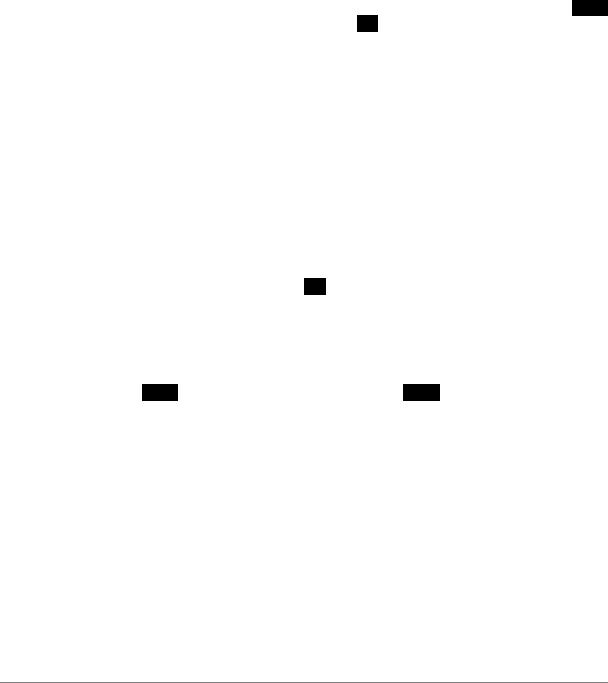
dCS 904 User Manual |
Manual for Software Version 1.5x and 1.36 |
dCS Ltd |
June 2000 |
|
|
The overload indication given by the dCS 904 is comprehensive. The detection circuitry monitoring the digital filter does not simply check the final output word but all the data from which the output word is formed. If any of these overload (this may not be apparent from the output data), an overload is flagged.
The filter itself has sufficient numerical accuracy that if the input data is not overloaded, the filter computations cannot generate an overload - only a raw data overload can cause an error. The overload indication is thus much more accurate than any external meter based indication - for this reason it is stored in the AES/EBU validity bit for later reference.
ADC/Data |
Menu |
Set |
The ADC/Data button is dual function – on its own (blue type on the front panel) it sets the input mode (analogue or digital). With the other menu buttons ( white type on the front panel) it is the menu Set button.
As an input mode switch, it switches between the analogue inputs (ADC mode) or a digital input on the AES Reference input (Data mode).
Data mode routes the digital input through to the outputs, and makes noise shaping, word length reduction and some reformatting available to it. For normal operation, this is set to ADC (LED off). In Data mode, the ADC/Data LED lights and the data stream on the AES Reference Input is output on the AES1-4 outputs. If the Reference Input sample rate is 88.2 or 96kS/s and the Output Format is Dual AES, the input will be converted to Dual AES on AES1 & 2 and AES3 & 4.
Data mode also affects the SDIF connectors (BNCs) in any DSD mode. The data lines (two of the four connectors) become inputs, and DSD fed into these is packed and re-formatted into the output format selected. No DSP is carried out.
For Menu operation as the Set button, see the section “The Software – the Menu” on page 18.
Master/Slave |
Menu |
Down |
The Master/Slave button is dual function – on its own (blue type on the front panel) it sets the clocking mode (master or slave). With the other menu buttons ( white type on the front panel) it is the menu Down button.
In Master mode, the calibrated voltage controlled crystal oscillators (VCXOs) inside the unit generate an accurate sample rate. The LED labelled Master will be lit to indicate this. If a Master Clock is available, this may be connected to the Reference In connector (for AES/EBU reference) or the 75R In connector (for SDIF-2 Word Clock). To slave the unit to the Master Clock, press the Master/Slave button. The unit will attempt to lock to the Reference - this will take a few seconds. If lock is achieved, the Slave LED will light up brightly and the Master LED will turn off. To return to Master mode, press the Master/Slave button again.
If both AES Reference and Word Clock are connected, pressing the Master/Slave button cycles through the sequence:
Master ... AES Reference ... Word Clock ... Master ... etc.
Manual part no: DOC135904 iss 2B2 |
Page 14 |
135904ma2b2.pdf file available from website |
Contact dCS on + 44 1799 531 999 |
email to: more@dcsltd.co.uk |
(inside the UK replace + 44 with 0) |
web site: www.dcsltd.co.uk |
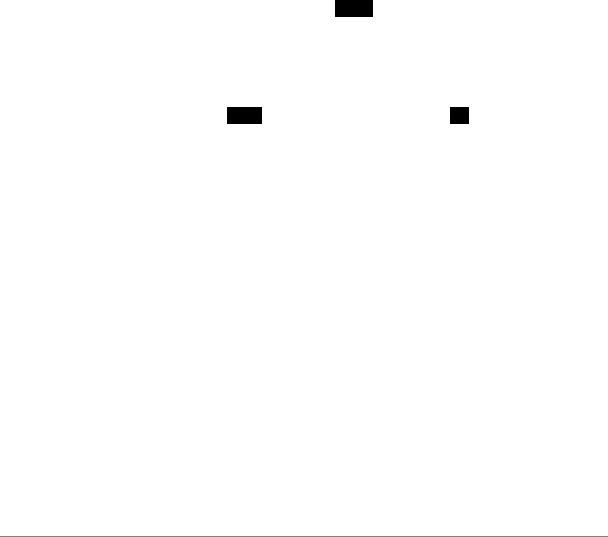
dCS 904 User Manual |
Manual for Software Version 1.5x and 1.36 |
dCS Ltd |
June 2000 |
|
|
If the active reference source is lost, the unit will select the next option in the sequence.
If the Auto-Slave option in the “Function Menu” is turned On the unit will automatically slave when a suitable reference is connected. If both AES Reference and Word Clock are connected, AES Reference takes priority. Word Clock may be selected by pressing the Master/Slave button – it moves down the priority list.
Once slaved, the unit can internally multiply the reference input sample rate by 2 or 4, if required, by pressing the Multiplier button. The Master Clock must be set to a suitable sample rate:
Master Clock Sample |
dCS 904 Sample Rate (kS/s) |
|
Rate (kS/s) |
|
|
32 |
32 |
|
44.1 |
44.1 or 88.2 or 176.4 |
|
48 |
48 or 96 or 192 |
|
88.2 |
88.2 or |
176.4 |
96 |
96 or |
192 |
Table 1 Reference Clock and Sample Rates
For Menu operation as the Menu Down button, see the section “The Software
– the Menu” on page 18.
Output Format |
Menu |
Up |
The Output Format button is dual function – on its own (blue type on the front panel) it sets the output format (single, dual, quad AES, etc). With the other menu buttons ( white type on the front panel) it is the Up button.
Pressing the Output Format button repeatedly causes the output format to cycle through the allowed options from the sequence:
Single AES ... Dual AES ... Quad AES ... Single AES ... etc.
If any format is not available at that sample rate, it is skipped from the sequence.
Mode Display
The single digit LED mode display to the right of the Format button shows the output format:
Display |
Output Format |
0 |
DSD mode, AES outputs turned off |
1 |
Single AES |
2 |
Dual AES |
3 |
P3D mode |
4 |
Quad AES or 4 wire DSD |
Table 2 Output Data format indication, higher sample rates
When the Output Format is selected, the main display briefly shows the format code:
Manual part no: DOC135904 iss 2B2 |
Page 15 |
135904ma2b2.pdf file available from website |
Contact dCS on + 44 1799 531 999 |
email to: more@dcsltd.co.uk |
(inside the UK replace + 44 with 0) |
web site: www.dcsltd.co.uk |
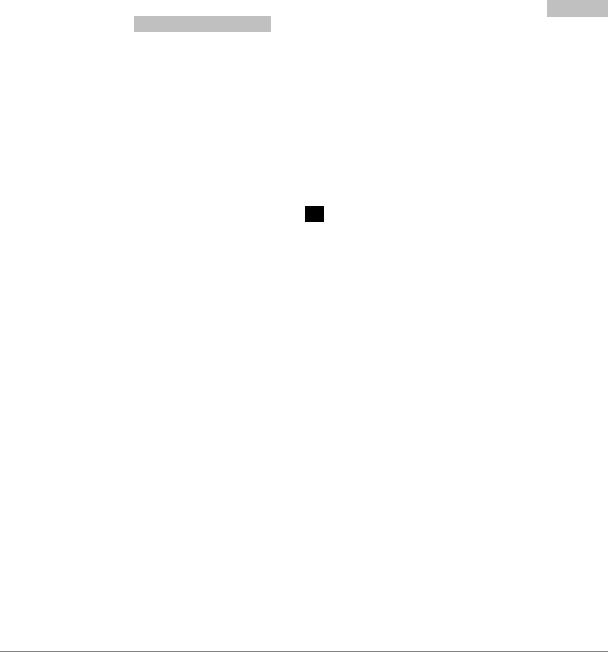
dCS 904 User Manual |
Manual for Software Version 1.5x and 1.36 |
dCS Ltd |
June 2000 |
|
|
A1 |
for Single AES, Standard speed encoding |
b1 |
for Single AES, Double speed encoding |
b2 |
for Dual AES, Standard speed encoding |
C2 |
for Dual AES, Double speed encoding |
C4 |
for Quad AES, Standard speed encoding |
If an invalid combination is selected (e.g. Single AES at 192kS/s), the invalid combination will flash (e.g. C1) then be replaced by the nearest available combination.
In Single AES mode, the same data stream is available on all four AES outputs. In Dual AES mode, two sets of identical data streams are available on AES1 & 2 and AES3 & 4 outputs. In Quad AES mode, the data stream uses all four AES outputs.
In DSD mode, data in the AES outputs can be turned off (leaving the unit just outputting an AES clock). This is controlled by the menu item DSD 4 (or AES O for P3D optioned units). See page 20.
dCS equipment encodes messaging into the various data streams to enable receiving equipment to tell what is going on, and to decide which wire is which, in the unlikely event of user wiring errors. Not all equipment from other manufacturers does this, so:
IMPORTANT! Take extra care when connecting Quad AES as it is very easy to connect the wires in the wrong order. If this is not detected, it may result in badly aliased mono signals being recorded. Numbering each connector is a sensible precaution.
For Menu operation as the Up button, see the section “The Software – the Menu” on page 18.
Sample Rate Display
The main LED display generally shows the sample rate, in kS/s, or the mode (DSD). When other parameters are set, it briefly shows the new setting (word length, noise shaping, etc) then reverts to its normal display. In the case of an error condition, it will display an error message.
If the unit is being slaved, the display also indicates which input connector it is slaved to.
xxxThe sample rate, in kS/s (32, 44.1, 48, 88.2, 86, 176.4, or 192).
- xxx |
Slaved to the BNC input (typically, word clock). |
-- xxx |
Slaved to AES Reference in. |
There are also some temporary displays that show what the unit is doing during its locking phase:
d xxx |
Temporary display |
during locking – the unit has |
|
detected the base |
reference sample rate and is |
|
attempting to lock to it. |
|
. xxx |
Temporary display during locking – the unit is lining |
|
|
up word clock out to word clock in. |
|
Important error messages are given below – a full list is given in the section
Error Codes and Messages on page 74.
Manual part no: DOC135904 iss 2B2 |
Page 16 |
135904ma2b2.pdf file available from website |
Contact dCS on + 44 1799 531 999 |
email to: more@dcsltd.co.uk |
(inside the UK replace + 44 with 0) |
web site: www.dcsltd.co.uk |
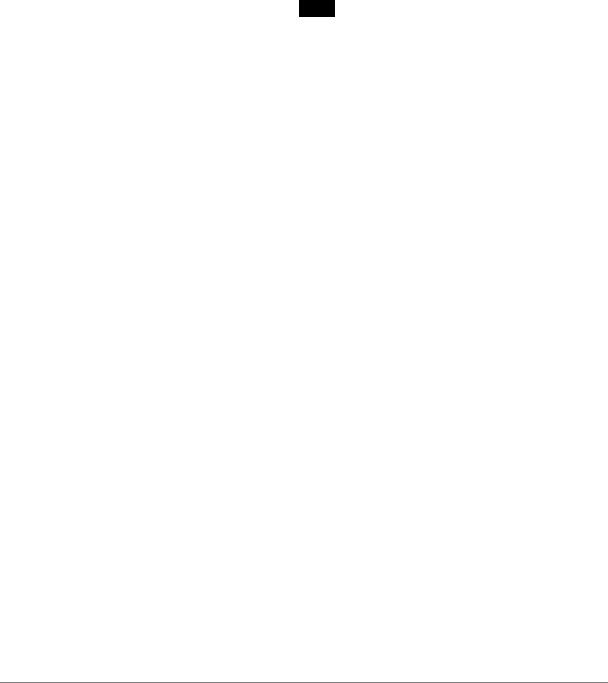
dCS 904 User Manual |
Manual for Software Version 1.5x and 1.36 |
dCS Ltd |
June 2000 |
|
|
BadFs |
The clock source is not in pull in range, or is poorly |
|
formatted. The unit cannot lock to it. |
Err.xy |
An error has been detected. Please refer to |
|
“Internal Device Error Codes” on page 74 for |
|
more specific details on error codes. |
Hot |
The unit is overheating, probably due to inadequate |
|
ventilation. Please check positioning and cooling. |
Ouch |
The “Hot” warning has been ignored and the unit is |
|
getting so hot damage may follow. |
(blank) |
If the display is completely blank for any significant |
|
period, try switching off for 10 seconds then |
|
switching on again. If this does not solve the |
|
problem, contact your distributor or dCS. |
The display is also used for Menu options.
Manual part no: DOC135904 iss 2B2 |
Page 17 |
135904ma2b2.pdf file available from website |
Contact dCS on + 44 1799 531 999 |
email to: more@dcsltd.co.uk |
(inside the UK replace + 44 with 0) |
web site: www.dcsltd.co.uk |

dCS 904 User Manual |
Manual for Software Version 1.5x and 1.36 |
dCS Ltd |
June 2000 |
|
|
THE SOFTWARE – THE MENU
Overview
The dCS 904 has many other functions that either need to be accessed only occasionally, or are informative in nature. These functions can be accessed either by the Remote software, running on a PC and connected to the unit by an RS-232 link - or (in most cases) by the Menu. If a function is set by the menu or the Remote, the unit remembers it, and it will be set this way for ever (or until you set it to something different). You can customise your unit in this way. Information only items are displayed for a time, then the display reverts to normal.
Menu buttons are indicated by white text on the front panel. There are for:
|
Step |
|
|
otherwise Overload Level |
||
|
Set |
|
|
|
otherwise ADC/Data |
|
|
Down |
otherwise Master/Slave |
||||
|
Up |
|
|
otherwise Output Format |
||
|
Back |
|
otherwise Noise Shaping |
|||
Entering the Menu |
|
|||||
The Menu is entered by holding down the Step and then pressing the Set button once. The display will show:
Func
You are now in the menu, and the menu buttons now have their alternate meanings.
Moving through the Menu
Press the Step button again to step through the Menu items listed below. When you reach the required item, press the Set button once to display the current setting, and press again to change its setting. This either toggles the previous state, or causes an information function to read out, or enters a lower level (as in the Tone generator, for example). If you have entered a lower level, pressing Step steps through its options. When you reach the one you want, press Set and then use the Up or Down buttons to increase or decrease a value (such as Level or Frequency on the Tone generator).
If no changes are made in 4 seconds, the unit exits the Menu. When one item has been set, press the Step button again if you wish to continue cycling through the Menu.
There is a knack in doing this easily – once it has been gained, it becomes very easy to use the functions it accesses.
Manual part no: DOC135904 iss 2B2 |
Page 18 |
135904ma2b2.pdf file available from website |
Contact dCS on + 44 1799 531 999 |
email to: more@dcsltd.co.uk |
(inside the UK replace + 44 with 0) |
web site: www.dcsltd.co.uk |
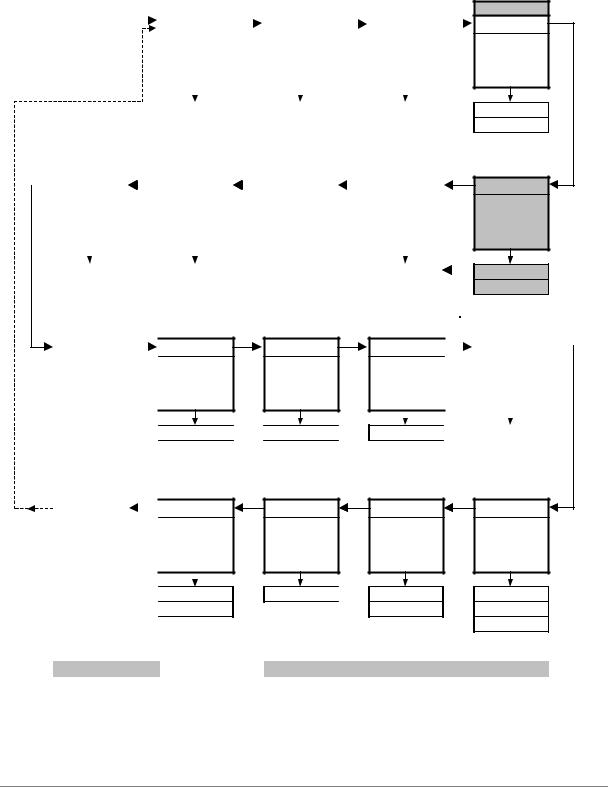
dCS 904 User Manual |
Manual for Software Version 1.5x and 1.36 |
dCS Ltd |
June 2000 |
|
|
The Menu Sequence
To access the Function Menu, hold down the Menu Step button and press the Menu Set button. To step through the Menu items, press the Menu Step button repeatedly.
To step back, press the Noise Shaping button.
To select an item or one of its options, press the Menu Set button.
To exit the Function Menu, either select the End item or wait five seconds.
|
Func |
|
|
|
Issue |
|
|
|
Filt |
|
|
|
DSD |
|
|
|
|
||||
|
|
|
|
|
|
|
|
|
|
|
|
|
|
||||||||
|
|
|
|
|
|
|
|
|
|
|
|
|
|
||||||||
|
Opens the |
|
|
|
Displays the |
|
|
|
Selects an |
|
|
|
Selects DSD |
|
|
|
|
||||
|
|
|
|
fitted software |
|
|
|
alternative |
|
|
|
|
|
|
|
||||||
|
Function Menu |
|
|
|
|
|
|
|
|
|
mode |
|
|
|
|
||||||
|
|
|
|
issue number |
|
|
|
filter |
|
|
|
|
|
|
|
||||||
|
|
|
|
|
|
|
|
|
|
|
|
|
|
|
|
|
|
||||
|
|
|
|
|
|
|
|
|
|
|
|
|
|
|
|
|
|
|
|
|
|
|
|
|
|
|
|
|
|
|
|
|
|
|
|
|
|
|
|
|
|
|
|
|
|
|
|
|
|
|
|
|
|
|
|
|
|
|
|
|
|
|
|
|
|
|
|
|
|
|
|
v 1.50 |
|
|
|
Filt 1 |
|
|
|
Off |
|
|
|
|
|||
|
|
|
|
|
|
|
|
|
|
|
Filt 2 |
|
|
|
On |
|
|
|
|
||
|
|
|
|
|
|
|
|
|
|
|
… |
|
|
|
P3D |
|
|
|
|
||
|
|
|
|
|
|
|
|
|
|
|
Filt n |
|
|
|
DSD4 |
|
|
|
|
||
|
|
|
|
|
|
|
|
|
|
|
|
|
|
|
|
|
|
|
|
|
|
|
Heat |
|
|
|
7 - Seg |
|
|
|
Test |
|
|
|
Tone |
|
|
|
|
||||
|
|
|
|
|
|
|
|
|
|
|
|
|
|
||||||||
|
Displays the |
|
|
|
Disables the 7- |
|
|
|
Runs a display |
|
|
|
Turns on and |
|
|
|
|
||||
|
internal |
|
|
|
segment display |
|
|
|
and DSP self |
|
|
|
|
|
|
|
|||||
|
|
|
|
|
|
|
|
|
|
sets a test tone |
|
|
|
|
|||||||
|
temperature |
|
|
|
when idle. |
|
|
|
test routine |
|
|
|
|
|
|
|
|||||
|
|
|
|
|
|
|
|
|
|
|
|
|
|
|
|
||||||
|
|
|
|
|
|
|
|
|
|
|
|
|
|
|
|
|
|
|
|
|
|
|
|
|
|
|
|
|
|
|
|
|
|
|
|
|
|
|
|
|
|
|
|
|
|
|
|
|
|
|
|
|
|
|
|
|
|
|
|
|
|
|
|
|
|
|
Fahrenheit |
|
|
|
On |
|
|
|
|
|
|
|
|
Level (dB) |
|
|
|
|
|||
|
|
|
|
|
|
|
|
|
|
|
|
|
|
|
|
||||||
|
Celsius |
|
|
|
Off |
|
|
|
|
|
|
|
|
Freq (kHz) |
|
|
|
|
|||
|
|
|
|
|
|
|
|
|
|
|
|
|
|
|
|
On / Off |
|
|
|
|
|
|
|
|
|
|
|
|
|
|
|
|
|
|
|
|
|
Up |
|
|
|
|
|
|
|
|
|
|
|
|
|
|
|
|
|
|
|
|
|
|
|
|
|
||
AES 0
DSD 4
Enables DSD on AES 1-4 XLR outputs
Off
On
DSD 0
Selects DSD
SDIF format
SDIF2
SDIF3
Phone |
|
|
Part |
|
|
||
Displays dCS' |
|
|
Displays the |
telephone |
|
|
control PCB |
number |
|
|
part number |
|
|
|
|
 dCS002540?
dCS002540? 
End |
|
|
Loc |
|
|
|
|||
Exits the |
|
|
Locks out the |
|
|
|
front panel |
||
Function Menu |
|
|
||
|
|
controls |
||
|
|
|
||
|
|
|
|
|
|
|
|
|
|
|
|
|
Off |
|
|
|
|
||
|
|
|
On |
|
Standard software v1.5x.
P3D software v1.36.
S - No
Displays the control PCB serial number
 0002-540-?-?
0002-540-?-? 
Offst
Trims the mastermode VCXO frequency
+9.9 ~ -9.9ppm 
RS232 |
|
|
|
BNC O |
|
||
|
|
|
|
||||
Displays and |
|
|
Sets the mode |
|
|||
sets the unit's |
|
|
of the 75R Out |
|
|||
RS232 address |
|
|
connector |
|
|||
|
|
|
|
|
|
|
|
|
|
|
|
|
|
|
|
|
|
|
|
|
|
|
|
0 ... 99 |
|
|
|
SDIF |
|
||
DSD modes only { |
AES |
|
|||||
CL. 1 |
|
||||||
CL. 64 |
|
||||||
A - SL
Automatically slaves when ref input available
Off
On
Ref In
Sets the mode of the AES Ref I/O connectors
Loop
Loop.t
Int
Some features are not available in DSD mode.
P3D mode is only available on some hardware configurations
Figure 3 – Menu Sequence
Manual part no: DOC135904 iss 2B2 |
Page 19 |
135904ma2b2.pdf file available from website |
Contact dCS on + 44 1799 531 999 |
email to: more@dcsltd.co.uk |
(inside the UK replace + 44 with 0) |
web site: www.dcsltd.co.uk |
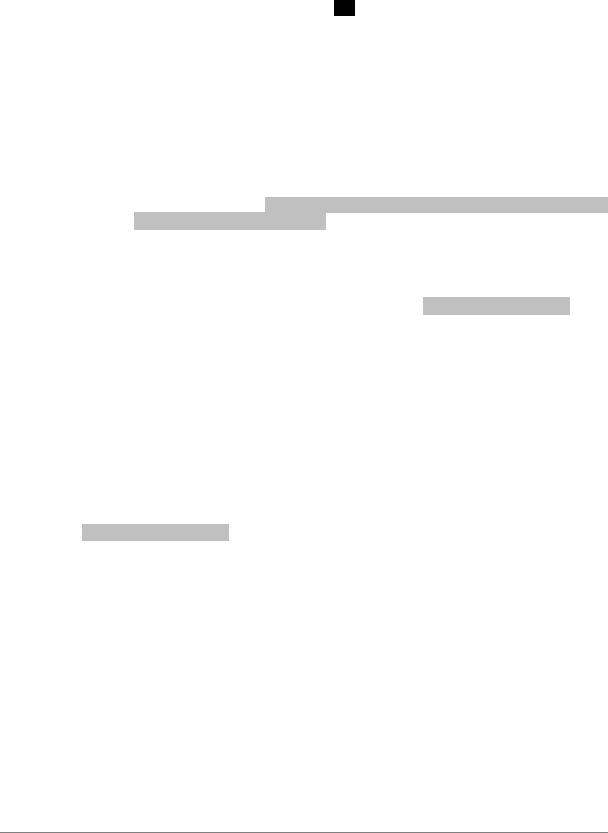
dCS 904 User Manual |
Manual for Software Version 1.5x and 1.36 |
dCS Ltd |
June 2000 |
|
|
Menu Items
Issue
Displays the software issue when Set is pressed.
Filt
Selects one of several anti-alias filter responses. The filters should be evaluated by ear. Filt1 gives the sharpest cut off, just below half the sampling frequency. This is the normal setting. Filt2, Filt3, Filt4 give progressively more relaxed responses, degrading the alias performance but sharpening the impulse response. This affects the stereo or multi-channel image. Different filters may be appropriate for different material.
DSD
Turns on DSD mode and in P3D units cycles through the DSD format options available (Off, On, P3D, DSD 4). When on, the unit displays “dSd”. The mode takes about 15 seconds to load, during which time the menu cannot be used. This mode is so different from PCM that most of the PCM related front panel buttons are no longer appropriate. DSD is output on the BNC connectors, and the following other changes occur:
-XLR outputs are clock only unless DSD 4 (or AES O on P3D units) is on (see below).
-the BNC O options change to CL 1 (bit clock) or CL 64 (word clock)
-ADC/Data allows the SDIF connectors to be turned into inputs, so that DSD data can be fed in and formatted
-Sample Rate, Multiplier, Mute, Word Length, Noise Shaping, Overload Level, and Output Format buttons do not work
-the Tone Generator does not work
The Master/Slave button works and the Auto Slave function (see later in Menu Items) works. Filt works – there are 7 filter options in DSD mode. See the section on “DSD” starting on page 32 for more details – they trade-off in-band and out-of-band noise.
DSD 4 (or AES O for P3D units)
This function controls the use of the XLR connectors on DSD mode. There are two options, whose behaviour depends on whether the unit is a P3D unit or not.
Standard (non P3D) units:
|
Off |
The XLRs carry AES clock only |
|
|
On |
The XLRs carry DSD data packed into 4 AES3 |
|
|
|
links for storage on 16 bit 8 channel 44.1 kS/s PCM |
|
|
|
machines (non P3D units) |
|
|
|
|
|
P3D units: |
|
|
|
|
|
|
|
|
Off |
XLRs carry AES clock only |
|
Manual part no: DOC135904 iss 2B2 |
Page 20 |
135904ma2b2.pdf file available from website |
Contact dCS on + 44 1799 531 999 |
email to: more@dcsltd.co.uk |
(inside the UK replace + 44 with 0) |
web site: www.dcsltd.co.uk |

dCS 904 User Manual |
Manual for Software Version 1.5x and 1.36 |
||
dCS Ltd |
June 2000 |
||
|
|
|
|
|
|
|
|
|
On |
XLRs carry either DSD 4 format or P3D format, as |
|
|
|
set by he DSD menu item. In P3D format, where |
|
|
|
DSD to be packed into 3 AES3 links, the 4th XLR |
|
|
|
output carries a PCM encoded signal for metering |
|
|
|
purposes, to allow DSD to be recorded on existing |
|
|
|
8 track 24 bit PCM recording machines, at a lower |
|
|
|
than normal level |
|
This XLR control function is separate from DSD mode for safety reasons. Because DSD into a PCM device can cause full scale noise, with a very high high frequency content that can damage speakers, this feature has to be explicitly turned on.
If it is turned on, and DSD mode is turned on, the unit outputs DSD packed into AES3 data streams in the appropriate manner. Contact dCS for further details
If DSD is packed into AES3 links (DSD 4 or P3D), the dCS 904 sets the Non Audio flag in the AES3 message, so that a DAC further downstream will mute if it cannot accept the format, but beware:
IMPORTANT! if the Non Audio flag is stripped by the recorder, a DAC could accept DSD data as AES3 PCM and will output potentially damaging full scale noise.
DSD O
This page selects the output format of the SDIF connectors – SDIF-2 or SDIF-3. SDIF-3 is only valid for DSD:
SDIF2 |
The BNCs output SDIF-2 formatted DSD in ADC |
|
mode |
On |
The BNCs output SDIF-3 (embedded clock) in |
|
ADC mode. |
Definitions of these formats are available from the SONY Corporation.
Tone
This accesses a test generator, whose level and frequency can be adjusted. Pressing Set enters a submenu, which accesses the following functions:
Level |
The output level, in dB0. It can be changed in |
||||||||
|
0.1dB steps using the |
Up |
and |
Down |
buttons. |
||||
Freq |
The output frequency, |
in |
|
kHz. |
It can be changed |
||||
|
below 1 kHz in 10 Hz steps, or above 1 kHz in |
||||||||
|
100 Hz steps by using the |
Up |
and |
Down |
buttons. |
||||
On/Off |
Toggles whether the generator |
is on or off. |
|||||||
Up |
Allows the menu to be re-entered to set other |
||||||||
|
functions. Alternatively, if left, the menu will just |
||||||||
|
time out keeping the last settings. |
||||||||
At power up, the generator is set to Off, 1 kHz and –18dB0 as a safety measure. When in use, if the generator is turned Off, the unit remembers the last frequency and level setting.
The generator frequency can be set to much finer (32 bit) resolution using the RS-232 control. See section “RS-232 Remote Control Interface” on page 53 for more details.
Manual part no: DOC135904 iss 2B2 |
Page 21 |
135904ma2b2.pdf file available from website |
Contact dCS on + 44 1799 531 999 |
email to: more@dcsltd.co.uk |
(inside the UK replace + 44 with 0) |
web site: www.dcsltd.co.uk |
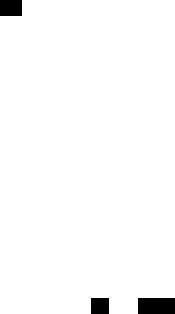
dCS 904 User Manual |
Manual for Software Version 1.5x and 1.36 |
dCS Ltd |
June 2000 |
|
|
Test
Runs a display and DSP self test routine. When successfully completed, the unit displays Pass and returns to normal operation. Otherwise an error message Err.xy is displayed – please refer to “Error Codes and Messages” on page 74 for more specific information.
7-Seg
Disables the 7 segment LED display. When set to Off, the display turns off 4 seconds after the last button press. A dot in the lower right hand corner of the display remains lit to indicate that the display has been deliberately blanked. The display springs back into life (temporarily) if the menu is used subsequently. Error or warning messages are displayed regardless of this setting.
Heat
Displays the internal temperature of the unit, measured near the internal VCXOs. Press Set to toggle between Fahrenheit and Celsius. See section
“Operating Conditions” on page 63
Phone
dCS telephone number scrolls across the display
Part
The control board part number (version) scrolls along the display.
S-No
The control board serial number scrolls along the display. You will need something to write this on, if you call us for help.
RS232
Displays - and allows access to – the unit’s RS-232 identity code (an address between 0 and 99). This is used by the remote control software, to send specific messages to specific units. Use Up and Down to change this address if you are operating several units in a multichannel set up.
IMPORTANT! Each unit in the daisy chain MUST be set to a different RS-232 address.
BNC O
Sets the format of the 75 ohm BNC outputs, and changes depending on whether the unit is in PCM or DSD modes. In PCM mode, the options are
AES |
Sends out AES3 coded data, but at TTL levels, at |
|
up to 96 kS/s on the Clk Out connector. |
SDIF |
Sends out SDIF-2 encoded data, with a word clock |
|
on the Clk Out connector. |
In DSD mode, the options are changed to:
CL 1 |
Sends out DSD data along with a bit clock on the |
|
|
Clk Out connector. |
|
CL64 |
Sends out DSD data along with a word clock on the |
|
|
Clk Out connector. |
|
|
|
|
Manual part no: DOC135904 iss 2B2 |
Page 22 |
135904ma2b2.pdf file available from website |
Contact dCS on + 44 1799 531 999 |
email to: more@dcsltd.co.uk |
(inside the UK replace + 44 with 0) |
web site: www.dcsltd.co.uk |

dCS 904 User Manual |
Manual for Software Version 1.5x and 1.36 |
dCS Ltd |
June 2000 |
|
|
Ref In
Sets the mode of the AES Reference In/Out connectors. The options are:
Loop |
Loops the input through to the output, with no |
|
termination resistor (termination is then about |
|
1kohm, so several units can be daisy chained). |
Loop.t |
As above, but terminates the input. Use at the end |
|
of a daisy chain. |
Int |
The output (and input in parallel – beware!) is |
|
internally driven, with the same signal as AES 1. |
A-SL
Turns Auto-slaving On or Off. When set to On, connecting an AES/EBU reference or a word clock in causes the unit to slave and lights the Slave LED. If both are present, the unit picks the highest priority one (AES/EBU) unless the Master/Slave button is used to move down the priority list. When set to Off, the unit does not react when a reference is connected.
Offst
Trims the appropriate VCXO frequency in master mode, by up to ±9.9ppm in 0.1ppm steps. Use the Up and Down buttons to change this setting, hold a button down to accelerate the change. The trim is remembered.
Loc
Panel Lock, normally Off. Set to On to prevent unauthorised changes using buttons. The menu has to be accessed to turn the lock off again.
End
Exits the menu.
Manual part no: DOC135904 iss 2B2 |
Page 23 |
135904ma2b2.pdf file available from website |
Contact dCS on + 44 1799 531 999 |
email to: more@dcsltd.co.uk |
(inside the UK replace + 44 with 0) |
web site: www.dcsltd.co.uk |
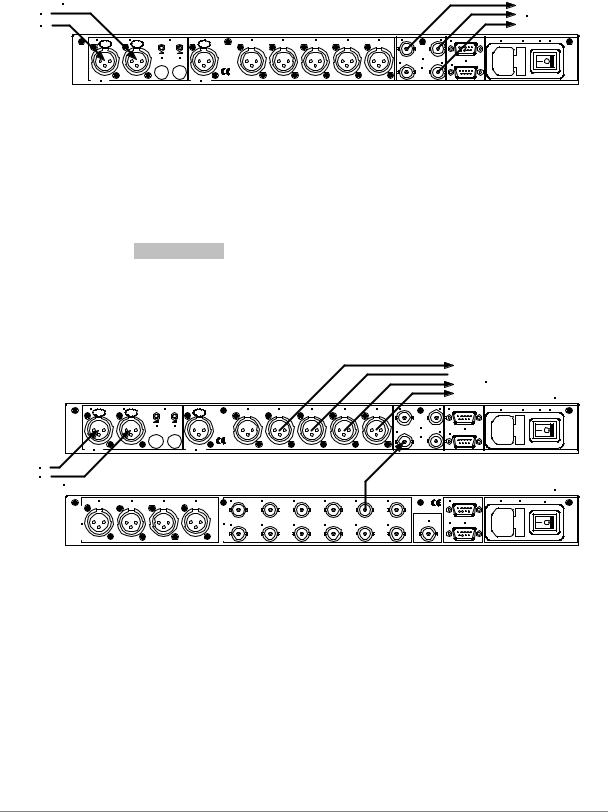
dCS 904 User Manual |
Manual for Software Version 1.5x and 1.36 |
dCS Ltd |
June 2000 |
|
|
TYPICAL APPLICATIONS
Using a dCS 904 to output DSD
Analogue source |
|
|
|
|
|
|
|
DSD |
CH2 |
|
|
|
|
|
|
|
|
CH1 |
|
|
|
|
|
|
|
Out |
|
|
|
|
|
|
|
|
|
CH1(L) |
CH2(R) |
Sensitivity Reference In |
Reference Out AES1 |
AES2 |
AES3 |
AES4 CH1 |
CH2 In |
MAINS FUSE 2A(T) ON OFF |
PUSH |
PUSH |
PUSH |
|
CH1(L) CH2(R) |
SDIF-2/DSD |
Remote |
|
In |
75R |
Out Out |
|
|
Clk |
|
Analogue |
Digital I/O |
|
|
|
Figure 4 – DSD output configuration |
||
do this: |
Set DSD in the menu to On. |
|
|
do this: |
Most likely (check your other equipment) you will need word clock. Make |
||
do this: |
sure BNC O is set to CL64. |
|
|
Select your filter. |
|
|
|
P3D units only:
do this: Set DSD to P3D or DSD4 instead of On as required
Using a Master Clock to Sync a dCS 904
 Single, Dual or
Single, Dual or
Quad AES
dCS 904
CH1(L) |
CH2(R) |
Sensitivity |
Reference In |
Reference Out |
AES1 |
AES2 |
AES3 |
AES4 |
CH1 |
|
CH2 |
In |
MAINS FUSE 2A(T) ON OFF |
PUSH |
PUSH |
|
PUSH |
|
|
|
|
|
|
|
|
|
|
|
|
CH1(L) CH2(R) |
|
|
|
|
|
|
In |
SDIF-2/DSD |
Out |
|
Remote |
|
|
|
|
|
|
|
|
|
Out |
||||
|
|
|
|
|
|
|
|
|
75R |
|
|||
|
|
|
|
|
|
|
|
|
|
Clk |
|
|
|
Analogue |
|
|
Digital I/O |
|
|
|
|
|
|
|
|
|
|
CH1
CH2
Analogue source
AES 1 |
AES 2 |
AES 3 |
AES 4 |
|
1 |
Outputs |
|
|
|
Outputs |
|
AES/EBU |
|
|
|
Wordclock |
7 |
dCS 992
2 |
3 |
4 |
5 |
6 |
|
In |
Mains Fuse (2AT) |
On Off |
|
|
|
|
|
External |
Loop |
Remote |
|
8 |
9 |
10 |
11 |
12 |
Sync |
|
||
|
Out |
|
|
Figure 5 – Syncing a dCS 904 to a Master Clock do this: Make sure A-SL (Autoslave) is On and DSD is set to Off
Manual part no: DOC135904 iss 2B2 |
Page 24 |
135904ma2b2.pdf file available from website |
Contact dCS on + 44 1799 531 999 |
email to: more@dcsltd.co.uk |
(inside the UK replace + 44 with 0) |
web site: www.dcsltd.co.uk |
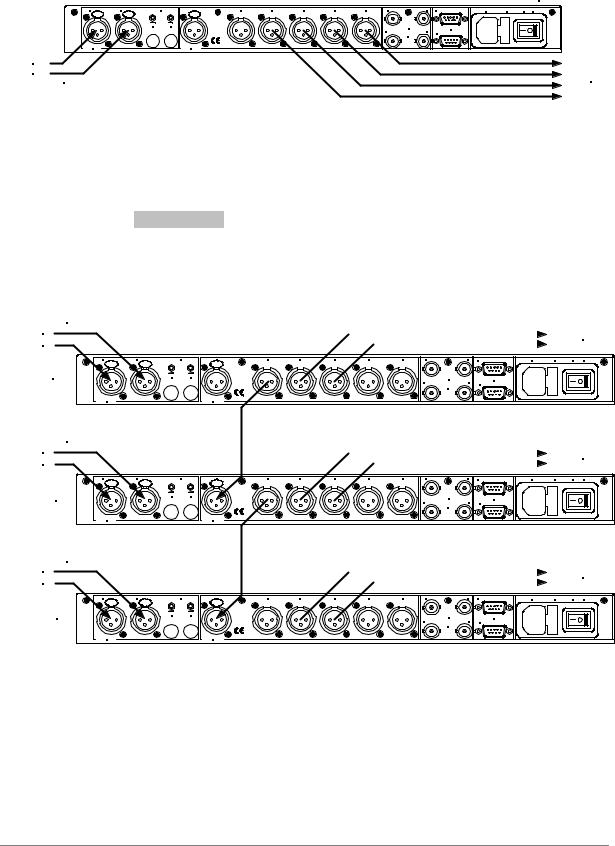
dCS 904 User Manual |
Manual for Software Version 1.5x and 1.36 |
dCS Ltd |
June 2000 |
|
|
Storing DSD on an 8 track 16/44.1 PCM Recorder
dCS 904
CH1(L) |
CH2(R) |
Sensitivity |
Reference In |
Reference Out |
AES1 |
AES2 |
AES3 |
AES4 |
CH1 |
CH2 In |
MAINS FUSE 2A(T) ON OFF |
PUSH |
PUSH |
PUSH |
CH1(L) |
CH2(R) |
SDIF-2/DSD |
Remote |
|
|
||
|
In |
75R |
Out Out |
|
|
Clk |
|
Analogue |
Digital I/O |
|
|
CH1 |
|
|
To 8 channel |
CH2 |
|
|
|
Analogue source |
|
|
44.1kS/s |
|
|
|
16 bit recorder |
Figure 6 – Storing 2 channel DSD on an 8 track 16 bit 44.1 kS/s PCM recorder
do this: Set DSD to On and DSD 4 to On
P3D units only:
do this: Set DSD to DSD 4, set AES O to On.
Six Channel PCM Set Up
Analogue source |
|
|
|
CH2 |
|
|
24/96 Dual AES |
|
|
||
CH1 |
|
|
Channels 1 & 2 |
|
|
MASTER
CH1(L) |
CH2(R) |
Sensitivity |
Reference In |
Reference Out |
AES1 |
AES2 |
AES3 |
AES4 |
CH1 |
CH2 In |
MAINS FUSE 2A(T) ON OFF |
PUSH |
PUSH |
PUSH |
CH1(L) CH2(R) |
SDIF-2/DSD |
|
Remote |
|
In |
Out |
|||
75R |
Out |
|||
|
Clk |
|
|
Analogue |
Digital I/O |
Analogue source |
|
|
|
CH4 |
|
|
24/96 Dual AES |
|
|
||
CH3 |
|
|
Channels 3 & 4 |
|
|
SLAVE
CH1(L) |
CH2(R) |
Sensitivity |
Reference In |
Reference Out |
AES1 |
AES2 |
AES3 |
AES4 |
CH1 |
CH2 In |
MAINS FUSE 2A(T) ON OFF |
PUSH |
PUSH |
PUSH |
CH1(L) CH2(R) |
SDIF-2/DSD |
|
Remote |
|
In |
Out |
|||
75R |
Out |
|||
|
Clk |
|
|
Analogue |
Digital I/O |
Analogue source |
|
|
|
CH6 |
|
|
24/96 Dual AES |
|
|
||
CH5 |
|
|
Channels 5 & 6 |
|
|
SLAVE
CH1(L) |
CH2(R) |
Sensitivity |
Reference In |
Reference Out |
AES1 |
AES2 |
AES3 |
AES4 |
CH1 |
|
CH2 |
In |
MAINS FUSE 2A(T) ON OFF |
PUSH |
PUSH |
|
PUSH |
|
|
|
|
|
|
|
|
|
|
|
|
CH1(L) CH2(R) |
|
|
|
|
|
|
In |
SDIF-2/DSD |
Out |
|
Remote |
|
|
|
|
|
|
|
|
|
Out |
||||
|
|
|
|
|
|
|
|
|
75R |
|
|||
|
|
|
|
|
|
|
|
|
|
Clk |
|
|
|
Analogue |
|
|
Digital I/O |
|
|
|
|
|
|
|
|
|
|
Figure 7 – Six channel set up without a Master Clock
The top dCS 904 needs to have its Ref In option set to Int. The middle one should be set to Loop, and the bottom one should be set to Loop.t. The units self align quite accurately (see “Sample Alignment” on page 37 onwards). Alternatively, word clock may be used as the syncing method, with no special set ups.
Manual part no: DOC135904 iss 2B2 |
Page 25 |
135904ma2b2.pdf file available from website |
Contact dCS on + 44 1799 531 999 |
email to: more@dcsltd.co.uk |
(inside the UK replace + 44 with 0) |
web site: www.dcsltd.co.uk |

dCS 904 User Manual |
Manual for Software Version 1.5x and 1.36 |
dCS Ltd |
June 2000 |
|
|
Storing 6 channel DSD on a 24 track 16/44.1 PCM Recorder
dCS 904
CH1(L) |
CH2(R) |
Sensitivity |
Reference In |
Reference Out |
AES1 |
AES2 |
AES3 |
AES4 |
CH1 |
CH2 In |
MAINS FUSE 2A(T) ON OFF |
PUSH |
PUSH |
PUSH |
CH1(L) |
CH2(R) |
SDIF-2/DSD |
|
Remote |
|
MASTER |
In |
Out |
|||
75R |
Out |
||||
|
|
Clk |
|
|
|
Analogue |
Digital I/O |
|
|
|
CH1
CH2
Analogue source
|
|
|
|
|
|
|
|
|
|
|
dCS 904 |
CH1(L) |
CH2(R) |
Sensitivity |
Reference In |
Reference Out |
AES1 |
AES2 |
AES3 |
AES4 |
CH1 |
CH2 In |
MAINS FUSE 2A(T) ON OFF |
PUSH |
PUSH |
PUSH |
CH1(L) |
CH2(R) |
SDIF-2/DSD |
|
Remote |
|
SLAVE |
In |
Out |
|||
75R |
Out |
||||
|
|
Clk |
|
|
|
Analogue |
Digital I/O |
|
|
|
CH3
CH4
Analogue source
|
|
|
|
|
|
|
|
|
|
|
dCS 904 |
CH1(L) |
CH2(R) |
Sensitivity |
Reference In |
Reference Out |
AES1 |
AES2 |
AES3 |
AES4 |
CH1 |
CH2 In |
MAINS FUSE 2A(T) ON OFF |
PUSH |
PUSH |
|
PUSH |
|
|
|
|
|
|
|
|
CH1(L) |
CH2(R) |
SDIF-2/DSD |
|
Remote |
|
SLAVE |
In |
Out |
|||
75R |
Out |
||||
|
|
Clk |
|
|
|
Analogue |
Digital I/O |
|
|
|
CH5
CH6
Analogue source
To 24 channel 44.1kS/s
16 bit recorder
Figure 8 – Six channel DSD recording on a 24 track 16/44.1 kS/s recorder
Make sure DSD 4 is turned on, from the menu. The top dCS 904 needs to have its Ref In option set to Int. The middle one should be set to Loop, and the bottom one should be set to Loop.t The units self align quite accurately (see “Sample Alignment” on page 37 onwards). Alternatively, word clock may be used as the syncing method, with no special set ups.
P3D option only:
do this: Set DSD to DSD 4, set AES O to On
Manual part no: DOC135904 iss 2B2 |
Page 26 |
135904ma2b2.pdf file available from website |
Contact dCS on + 44 1799 531 999 |
email to: more@dcsltd.co.uk |
(inside the UK replace + 44 with 0) |
web site: www.dcsltd.co.uk |
